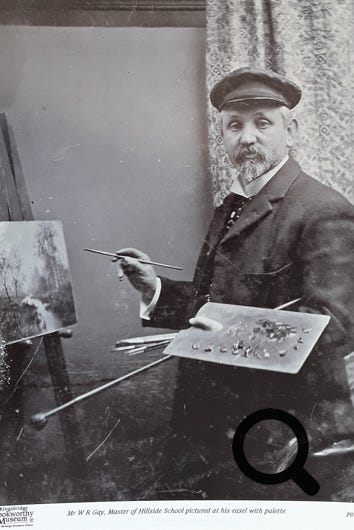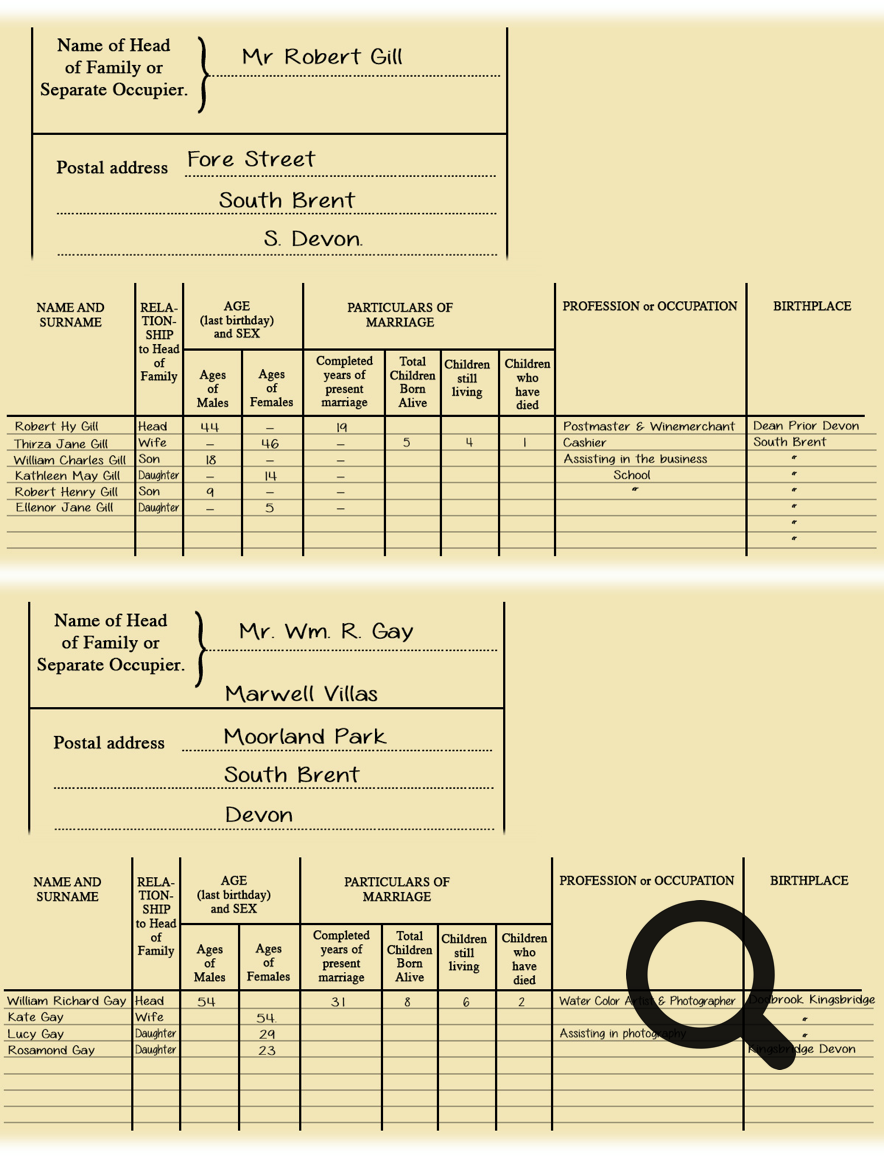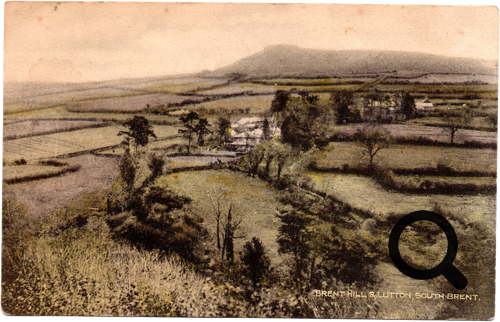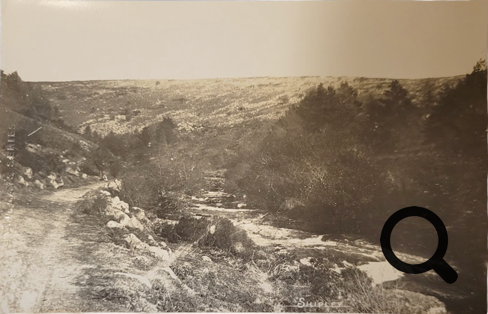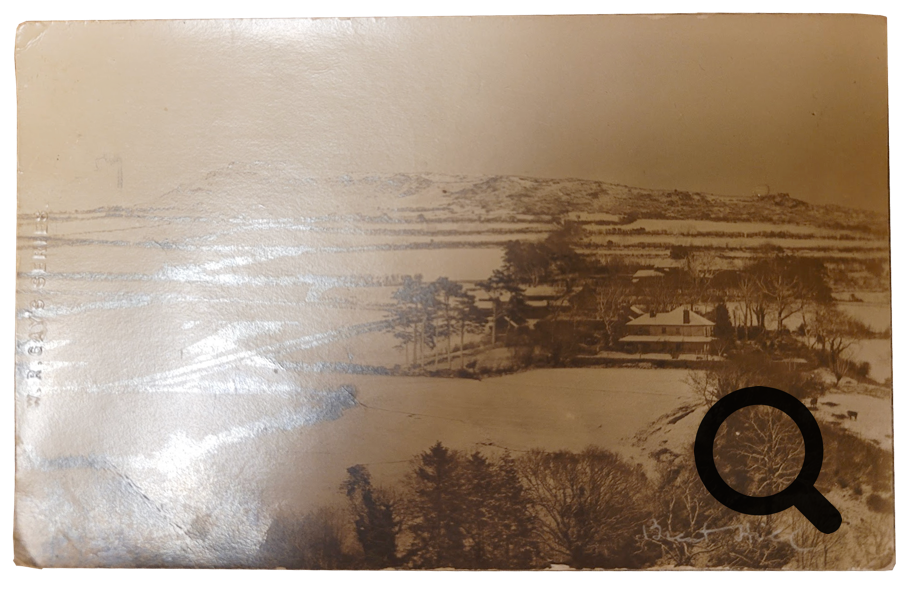Lily Style Author
Gill and Gay: Pioneering Postcard-makers of Brent
On 9th September 1910, Western Times (below) reported the results of a massive, local drive to support the area’s GP, Dr Style who was recovering from a major injury. The pivotal players, W R Gay and R H Gill were both pioneering postcard-makers.
SOUTH BRENT
The presentation of the testimonial so generously and readily subscribed to by several hundred of residents of Brent, Ugborough, Diptford, Rattery, Avonwick and North Hush, etc. was privately made to Dr. Style at his residence on Monday evening. The deputation elected by the general committee for the purpose[,] satisfactorily carried out the wishes of the subscribers as expressed at the meeting. It is intended that the illuminated address with book of names––designed and arranged by Mr. W. R. Gay––shall within a week or two, be on view in the window of the Brent Post Office, by kind permission of Mr. R. H. Gill…
A short history of British postcards
According to Postal Museum’s website, although postcards were popular in Britain in the 1870s, the Post Office didn’t accept illustrated ones until 1894. The modern layout (with the back divided for correspondence on the left, and the address on the right) wasn’t permitted by the Post Office until 1902. According to World Postcard Day’s website:
R. H. Gill: South Brent postmaster
Robert Henry Gill’s birth in Dean Prior was registered in the last quarter of 1866. His father, William, was South Brent-born, but took labouring jobs where he could find them. His mother, Eliza, died in 1878 when he was eleven. The 1881 census shows him in South Brent working as a postal telegraph boy. In 1891, he was resident in the post office, working as a ‘telegraphist’. He married Thirza Jane Farleigh on 13th September 1891. He was made postmaster, at the age of 28, in 1894 (Totnes Times, 23rd June 1894):
Gill immediately commissioned the construction of a new post office building next-door, opposite the Anchor Inn (the modern-day village shop). This building was still in use as the village post office until the 2010s. Totnes Times, on 1st September 1894, vividly describe what it was like when first opened:
The turn of the century saw the golden era of postcards. An article on the Standard (a British newspaper) from August 21, 1899 read:
"The illustrated postcard craze, like the influenza, has spread to these islands from the Continent, where it has been raging with considerable severity. “
With multiple daily pickups and deliveries (up to 12 times per day in large cities!), postcards were effectively the text messages of their time. It was cheap and convenient to send them, and postcard-obsession reached its peak in the Edwardian era with billions of them being sent every year.
When the 1901 census was taken, thirty-four-year-old Robert H Gill is a baker and grocer, as well as postmaster. He is living with his wife, Thirza, at 3 Fore Street, and had children named Ernest Farleigh (12), William C (8) and Kathleen M (4).
Gill was in the news on 28th September 1904, when, according to Western Times:
SOUTH BRENT
Much satisfaction has been given at South Brent by the appointment of Mr. R. H. Gill as postmaster, in the place of Mr. H. Veale, deceased. Mr. Gill entered the post-office sixteen years ago as a telegraph messenger. His courteous and obliging manner has obtained him the hearty good wishes of the inhabitants. A new Post-office will be built on the premises adjoining the present office.
W. R. Gay: schoolmaster, artist & photographer
William Richard Gay was born in Dodbrooke, near Kingsbridge. His birth was registered in the second quarter of 1856. The 1861 census lists him as the elder of two young children living with their mother, Eliza; their fifty-five-year-old father, William Gay (a tanner) and their seventy-seven-year-old grandfather (also called William Gay) who was still working as a labourer despite his advanced years.
Aged twenty-two, Gay married local girl, Kate Chamberlain, on 7th August 1879, in Dodbrooke parish church. His occupation is given as schoolmaster. The 1881 census shows them living in a Dodbrooke house called Hillside with a baby daughter named Katie. According to Ivybridge Heritage & Archives Group, the address was a school ‘established in 1875… The syllabus included mercantile courses of instruction, drawing in all branches, fishing, and swimming under personal supervision!’ In 1891, they were still in Hillside, with Gay now listed as schoolmaster, and with six children (Katie, Lucy, Polly, William F, Harold Chamberlain, and Rosamond). Exeter and Plymouth Gazette reveal him to have been Hillside School’s headmaster. The 1901 census shows the Gays still in Hillside, but with his occupation changed to ‘artist’. Ivybridge Heritage & Archives Group pinpoint the Gays move to South Brent to 1902. They initially lived at ‘Farnborough, South Brent’, but were in Moorland Park from 1906. Ivybridge Heritage & Archives Group’s website says that Gay was:
[A] local man associated with postcards was the artist and photographer William Richard Gay. His work centred predominantly around the South Hams. Paintings of Burgh Island and Thurlestone Rock by Gay reside at the Cookworthy Museum in Kingsbridge.
The ‘W R Gay Series’ of postcards (carrying the words physically embossed into the card) feature many images of Ivybridge including scenes of Fore Street, scenes of Exeter Road (including The Sportsmans Arms), Ivybridge Railway Station, Ivybridge Viaduct, Stowford Paper Mill (including the fire of 1914), St John’s Church, the Congregational Church, the Woods and the Post Office. His postcards are now highly sought after and demand a premium on auction websites.
Totnes Weekly Times’ coverage of the opening of the village’s first gasworks, at Brent Mill, on 9th May 1908, records W. R. Gay saying, ‘it was his fortune––in the sense of health––when he came to reside at Brent, and now that he had completed seven years’ residence he could claim to be a Brentonian––(applause). In that time he had done his best in the matter of photographs and writing in the papers to forward claims of Brent as a health resort. They had an abundant water supply and rainfall, which they were told did not deteriorate health but conduced to it. Their fairs were vastly important. The town had extended more above the station than towards the gas works. Noland and Moorland Parks had been laid out and residences built, and more would be built.––(applause)…’
There’s no record of which health needs were met for Gay in South Brent, but the above, undated photo ( courtesy of Ivybridge Heritage & Archives Group) shows him in a wheel chair with a young-looking family. The photograph below (also courtesy of Ivybridge Heritage & Archives Group) is of an older Gay in his studio, presumably in their new-build Moorland Park house.
The Gays were Methodists. In December 1902, Totnes Weekly Times reports his daughters, Lucy and Pollie, fundraising for South Brent Congregational Church (now Moxley McDonald Architects, on Plymouth Road opposite the Old School). The next year, the Western Times note he’d been recently appointed as a manager of the village school.
Men of the community
There are frequent mentions of R. H. Gill and W. R. Gay in early twentieth century news reports about the South Brent community. Amongst many activities, they were involved in creating the present-day village hall; establishing a charitable nursing association; raising money for the village’s football and cricket clubs; organising sports at the pony show; a bible club; otter hunting; and supporting the anti-Irish independence Unionist party.
Gill was on the committee of South Brent Rifle Club; the 1902 committee for a new hall; and South Brent Nursing Association when it formed in 1901 – although he was one of three committee members to resign in 1905, because ‘Although they were fully in sympathy with the object, yet as businessmen their time was too limited.’ (Exeter and Plymouth Gazette, 27th January 1905). W. R. Gay joined the South Brent Nursing Association committee in 1906, and both he and Gill were long-term subscribers.
Gill, with the Misses Carew of Marley House (in the photo above) and the Messrs. W. H. Hawke, E. Luscombe, J. Gibbs, and F. H. A. Goodman, provided flowers for a dance at Millswood Hall to raise money for South Brent’s cricket and football clubs (Exeter and Plymouth Gazette, 17th February 1905). Gill and Gay were called as jury members for South Brent’s 1907 triennial Court Leet (Totnes Weekly Times, 30th November 1907).
As headmaster of the Council School (now the Old School Centre), Gay was one of the Brent School Managers, presided over by Lord of the Manor, Mr. J R T Kingwell. He was a chief speaker when the forty-sixth anniversary of the South Brent Congregational Church was observed in April 1907 (Western Times). In September 1907, Totnes Weekly Times reported that when the Dartmoor Otter Hounds met at Avonwick ‘among those present were Colonel R. H. Green (Master)… [and] W. R. Gay’. More prestigiously, he was director of sports at South Brent’s annual horse show (Totnes Weekly Times, 17th July 1909):.
Gill was jury foreman at the inquest into the death of George Chubb, an elderly farmer, who ‘dropped down dead near Brent Station’ on the morning of 19th April 1910. The postmortem, carried out by Dr Frederick Style, revealed the cause of death to have been syncope (passing out) because of heart disease (Western Times).
On 14th October 1910, Exeter and Plymouth Gazette published a photo, by Hawkins of Plymouth, of ‘Mr. Robert H. Gill, of South Brent, Postmaster and general merchant, who has been installed as Worshipful Master of “Pleiades” Lodge (No. 710) of Freemasons at Totnes.’ In 1911, Gay presided over the annual district meeting of the British and Foreign Bible Society (Exeter and Plymouth Gazette 3rd February 1911). In November 1913, the same paper noted he was secretary of Brent Unionists (whose ‘billiard table was a good source of income as well as pleasure to its members.’ It was decided to have their second annual dinner in the Pack Horse Hotel in January). A 1919 notice in South Devon Weekly Express clarifies that the Unionists were a political party in opposition to Irish independence, and that their local MP, Lt. Col. Mildmay, had been reelected.
In 1910, Gill was on the re-assembled committee for the proposed new village hall. He was one of several villagers to buy shares to finance the venture, which culminated in the modern-day village hall being built the following year.
A number of Gay’s photos were featured in the local press during the second decade of the twentieth century. Exeter and Plymouth Gazette’s 23rd September 1910 issue includes his photo of ‘The competitors in the Baby Show held in connexion [sic] with the Unionists at Kingsbridge’, and the same paper’s 16th December 1910 coverage of MP Mildmay’s electoral victory for the Unionists is illustrated with Gay’s photograph of a triumphant, placard-wielding crowd in Totnes. Four years later, his photo of a traffic accident at Brent Mill Bridge was published by Exeter and Plymouth Gazette.
Gill and Gay in the 1911 census
Gill and Gay’s census entries (facsimiles below) show them both employing adult children as assistants. Eighteen-year-old William Charles Gay is ‘assisting in the business’, and twenty-nine-year-old Lucy Gay is ‘assisting with photography’. More sadly, both families had lost children. The Gills had lost one child (presumably their first-born, Ernest Farleigh, although no death record has yet come to light). The Gays had had a total of eight children, but lost two. Looking to Dodbrook, where the Gays lived until the turn of the century, parish records reveal the infant deaths of William Chamberlain Gay (d. 1885) and Clarisse Gay (d. 1891).
Gay’s short-lived comedian son
Local press, in the second decade of the twentieth century, is peppered with mentions of Gays in South Brent. W R Gay has multiple photo credits (for example, Exeter and Plymouth Gazette name him as the photographer of a nasty traffic accident on Brent Mill Bridge in March 1914). However, his second-youngest child, Harold Chamberlain Gay, has many mentions of his own. His birth was registered in Kingsbridge (the regional centre for Dodbrooke) in the last quarter of 1886. Western Times recorded Harold Gay as part of the pierrot troupe entertaining villagers for New Year’s Eve 1909 in Millswood hall. The 1911 census, taken on 2nd April, lists twenty-four-year-old Harold Gay as a comedian staying with the Symons family in Chillington, near Kingsbridge, but – a month later – the 12th May 1911 edition of the Western Morning News shows he was still very much involved in South Brent events. A Western Times’s 31st January 1913 report of ‘a good audience in Coronation Hall, South Brent… of a well-arranged concert in aid of funds for the Church Institute’ notes that ‘Harold Gay always wins an encore, and his song was re-demanded… A duet by Messrs. Harold Gay and Alex Smith created roars of laughter…’
On 28th February 1916, Western Times reported:
Funeral of Mr. Harold Gay at South Brent
After a long illness Mr. Harold Chamberlain Gay, younger son of Mr. and Mrs. W. R. Gay, of Moorland Park, South Brent (formerly Kingsbridge) passed away a few days ago. Mr. Gay, though only 29 years old, had by his kind and genial disposition made a large circle of friends in the district, who lament the loss of a popular favourite. Deceased was always interested in the promotion of any object which tended to the welfare of the parish and neighbourhood, and was always conspicuous on the stage of local amateurs. The funeral took place on Saturday in terrible weather, the snow being nearly a foot deep and bitterly cold. Notwithstanding a large number followed the body to the Parish Church, where a choral service was held, deceased being many years in the church choir… The cortege then proceeded to the new burial ground, where the interment took place, the Vicar (Rev. H. Speare-Cole) officiating. The mourners were Mr. W. R. Gay (father), Mr. W. F. Gay (brother), Misses Lucy and Rose Gay (sisters), Mr. W. Hodder (cousin), and Mr. Georges of Vermeulen. Among those present were Col. Bouchier, Major G. M. Conran, J.P… R. H. Gill…There was a very large number of wreaths, including one from Col. and Mrs. Mildmay and one from South Brent Constitutional Club.
Harold Gay’s death certificate states that he died on 22nd February 1916, aged 29, in Moorland Park. His death was reported by his father, W. R. Gay, who gave his occupation, not as an entertainer, but a photographer. The cause of his death, certified by Dr William Webb, was pulmonary tuberculosis and heart failure. It seems that the health-giving clean air of South Brent, that his father, W R Gay, had praised when speaking at the opening of the village gasworks in May 1908, had failed to preserve the health of his son, Harold.
His tombstone, in South Brent cemetery, bears two lines of verse composed by his father:
HAROLD CHAMBERLAIN
YOUNGEST SON OF
W. R. And K. GAY,
WHO FELL ASLEEP ON FEBRUARY 22 1916
AGED 29 YEARS.
UNTIL THE MORN
THAT MORN OF TEARLESS DAWN
W R G
ALSO POLLIE
SISTER OF THE ABOVE
DIED FEB. 21. 1931, AGED 48 YEARS
Conclusion
Robert Henry Gill and William Richard Gay were prominent figures in Edwardian South Brent. These two pioneering postcard-makers seem to have had a very amicable relationship, and worked together to coordinate the presentation of a community gift to South Brent’s GP, Dr Style, when he was recovering from a serious accident in 1910. Both had been born elsewhere in south Devon, but raised their families in South Brent. Gill and Gay were quick to embrace the new trend for picture postcards. For Gill, an entrepreneur who’d improved the village post office, producing and selling postcards was one of the many ventures he undertook in expanding the post office to sell groceries, sweets, baked goods and wine. For Gay, a schoolmaster and water colour artist, the route to postcard-making seems to have been from pursuing art, rather than business. Whether driven by commercial acumen or art, Gill and Gay have left a photographic legacy of Edwardian South Brent.
Acknowledgements
With thanks to Jonathan Nicholson for proofreading and providing the photo of the 1907 Marley House hunt.
Further thanks to Ivybridge Heritage for providing a wealth of information and photos of Gay and his family, and to Greg Wall for permitting the use of the photograph of Harold Chamberlain Gay first published in his book, South Brent and Its people Remembered.
Pre 1902 photo of W R Gay courtesy of Ivybridge Heritage & Archives Group
Photo of W R Gay in his studio courtesy of Ivybridge Heritage & Archives Group

Detail of Harold Chamberlain Gay from a pre-1916 photo of the Brent pierrot troupe, snapped by his father, W R Gay. First published in ‘South Brent and Its People Remembered’ by Greg Wall.
Left: Gill’s hand-tinted postcard of Lutton House and Brent Hill (author’s collection).
Below: W R Gay postcard of Shipley
(Author’s collection)
Early 20th century postcard of Lutton House, Brent Hill, in the snow, angled to show the embossed brand name ‘W R GAY’S SERIES’ (author’s collection).
